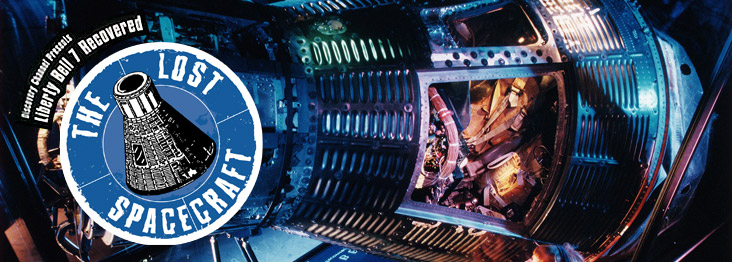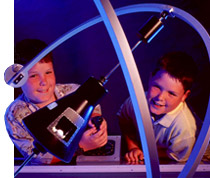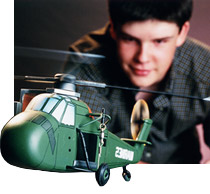HUMAN TRIUMPHS, TECHNOLOGICAL ADVANCES HIGHLIGHTED
It was America’s second manned space mission. It was the only NASA spacecraft lost and never recovered. It sat on the ocean floor for 38 years. Although its watery resting place was deeper than the Titanic’s and it is only the size of a refrigerator, Liberty Bell 7 was located and recovered in 1999. It is touring the United States in a blockbuster exhibit, “The Lost Spacecraft: Liberty Bell 7 Recovered.” Museum visitors across the nation are seeing the recovered spacecraft for the first time since its loss in 1961.
Discovery Channel, in partnership with Evergreen Exhibitions of San Antonio, Texas, produced and is touring this exhibit, which opened at Florida’s Kennedy Space Center.
The exhibit immerses visitors in environments that allow them to experience America in all its early space-pursuit glory. For example, a 1960’s living room has been re-created down to the 1961 news magazine on the coffee table, the popular television console and other home furnishings reminiscent of the period. The room is much like those in which millions of Americans sat riveted to their TVs while astronauts like Liberty Bell 7’s Capt. Gus Grissom rocketed into space.
Several interactive stations make this museum experience on early space flight something to remember. What’s it like to fly into space? A capsule simulator welcomes visitors to climb in the pilot’s seat of this tiny spacecraft and perform a pre-flight task. Less than half of the test launches of early rockets were successful. A rocket interactive allows visitors to look through a periscope and select from a series of rocket launch videos and discover each rocket’s fate.
Early astronauts were tested to determine their response to powerful G-forces experienced during a mission. Adults and children alike can climb into a real-life centrifuge and test themselves against the grit of astronauts in a main attraction in the exhibit. Through a joystick control interactive, visitors can maneuver a small helicopter model and attempt to recover a miniature version of the Liberty Bell 7. It couldn’t be accomplished in 1961; can you succeed today?
For 38 years Liberty Bell 7 lay on the ocean floor. Then, in spring 1999, Discovery Channel underwrote The Search for Liberty Bell 7 Expedition with Curt Newport, renowned underwater search and recovery expert, to find and retrieve the lost spacecraft.
Parents will be able to experience this exciting treasure hunt with their children. The exhibit offers a remarkable re-creation of the recovery ship deck, where they can peek into the recovery team’s daily log as it appeared on the Internet during the expedition. Another interactive allows visitors to conduct a virtual interview with Newport to discover why he pursued this adventure and what technology was necessary to achieve success.
The amazing ROV interactive, complete with robot arms and cameras, invites kids and parents to test their underwater piloting skills, just like the explorers who found the Liberty Bell 7 on the ocean floor more than 3 miles below the surface. Via computer, the museum visitor can use custom software that was developed to help identify sonar images of unknown objects miles beneath the ocean’s surface.
This high-tech software creates a video image from the rough sonar data. The visitor may select one of a number of images within a grid and then discover the object’s identity. Then comes the crown jewel of the exhibit. For the first time since it disappeared beneath the waves almost 40 years ago, Liberty Bell 7 sits silently and proudly for all to see. The spacecraft and its many artifacts tell their own quiet story about their 15 minutes in space and their 38 years on the ocean floor.
The project to preserve the capsule is a collaborative effort of Discovery Channel and the Smithsonian-affiliated Kansas Cosmosphere and Space Center, which will serve as the permanent home for the capsule after its nationwide tour.
Content Collaborator and Producer:
Discovery Channel and Discovery Wings Channel
Now Showing At:
Hutchinson, Kansas
Kansas Cosmosphere & Space Center
(Ongoing display)
Past Venues:
The Tech Museum, San Jose, California
Denver Museum of Nature & Science, Denver, Colorado
Liberty Science Center, Jersey City, New Jersey
St. Louis Science Center, St. Louis, Missouri
Kennedy Space Center, Cape Canaveral, Florida
The Children’s Museum, Indianapolis, Indiana
Boston Museum of Science, Boston, Massachusetts
Kirkpatrick Science and Air Museum, Oklahoma City, Oklahoma
Chabot Observatory, Oakland, California
Denver Museum of Nature and Science, Denver, Colorado
Kansas Cosmosphere and Space Center, Hutchinson, Kansas
Arizona Space Center, Phoenix, Arizona
ScienceCity, Kansas City, Missouri
Pink Palace, Memphis, Tennessee
U.S. Space and Rocket Center, Huntsville, Alabama
Space Center Houston, Houston, Texas
Virginia Air and Space Center, Hampton, Virginia
Adler Planetarium & Astronomy Museum, Chicago, Illinois
Strategic Air & Space Museum, Ashland, NE
Kennedy Space Center, Cape Canaveral, Florida
Lease Information:
Call Christi Klingelhefer at 210-599-0045.






